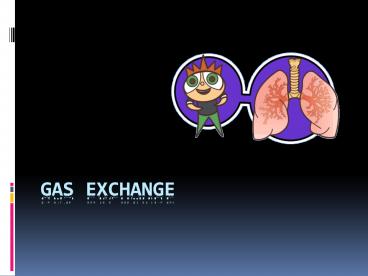Gas exchange - PowerPoint PPT Presentation
1 / 20
Title:
Gas exchange
Description:
Key concepts Gas exchange occurs across specialized respiratory surfaces Gills in aquatic animals Tracheal systems in insects Lungs Breathing ventilates the lungs ... – PowerPoint PPT presentation
Number of Views:109
Avg rating:3.0/5.0
Title: Gas exchange
1
Gas exchange
2
Key concepts
- Gas exchange occurs across specialized
respiratory surfaces - Gills in aquatic animals
- Tracheal systems in insects
- Lungs
- Breathing ventilates the lungs
- Amphibian breathing
- Bird breathing
- Control of breathing in humans
- Respiratory pigments bind and transport gases
- Diffusion and partial pressure
- Respiratory pigments
- O2 and CO2 transport
3
Vocabulary words
- respiratory surface
- tracheal system
- larynx
- bronchi (bronchus)
- breathing
- vital capacity
- partial pressure
- dissociation curve for hemoglobin
- ventilation
- lungs
- vocal cords
- bronchioles
- diaphragm
- residual volume
- respiratory pigments
- Bohr shift
- countercurrent exchange
- gills
- trachea
- alveoli (alveolus)
- tidal volume
- breathing control centers
- hemoglobin
- carbon dioxide transport
4
Respiratory surfaces and gas exchange
- Gas exchange uptake of O2 from environment and
discharge of CO2 - Mitochondria need O2 to produce more ATP, CO2 is
the by-product - C6H12O6 6O2 ? 6CO2 6H2O 36 ATP
- Diffusion rate
- a SA ? large
- a 1/d2 ? thin
- Moist so gases are dissolved first
DIFFUSION
5
Respiratory surfaces and gas exchange
- Respiratory surface
- Size of organism
- Habitat
- Metabolic demands
- Unicellular organisms
- Entire surface area for diffusion
- Simple invertebrates
- Sponges, cnidarians, flatworms
- diffusion
6
Respiratory surfaces and gas exchange
- More complex animals
- Thin, moist epithelium
- Separates medium from capillaries
- Entire outer skin ? small, long, thin organisms
- Specialized respiratory organs that are
extensively folded and branched
7
Gills in aquatic animals
- Outfoldings of the body surface suspended in
water - Sea stars
- Segmented worms or polychaetes
- Molluscs and crustaceans
- Fishes
- Young amphibians
- Total surface area is greater than the rest of
the body
8
Water as a respiratory medium
- Surfaces are kept moist
- O2 concentrations in water are low
- Ventilation increasing flow of respiratory
medium over the surface - Countercurrent exchange process in which two
fluids flow in opposite directions, maximizing
transfer rates - Why are gills impractical for land animals?
9
Air as a respiratory medium
- Air has a higher concentration of O2
- O2 and CO2 diffuse much faster in the air ? less
ventilation - Difficulty of keeping surface moist
- Solution respiratory infolding inside the body
- Tracheal system of insects network of tubes
that bring O2 to every cell
Spiracles
10
Lungs
- Heavy vascularized invaginations of the body
surface restricted to one location - Found in spiders, terrestrial snails, vertebrates
- Amphibians supplement lung breathing with skin
- Turtles supplement lung breathing with moist
surfaces in mouth and anus
11
Mammalian respiration
12
Lung ventilation through breathing
- Positive pressure breathing in frogs
- Gulping in air
- Negative pressure breathing in reptiles and
mammals - Rib muscles and diaphragm change lung volume and
pressure
13
Lung volumes
- Tidal volume
- Volume of air inhaled and exhaled with each
breath - Vital capacity
- Maximum volume inhaled and exhaled during forced
breathing - Residual volume
- Air left in alveoli after forced exhalation
- Factors
- Sex
- Height
- Smoking
- Physical activity
- Altitude
14
Avian breathing
Air sacs act as bellows to keep air flowing
through the lungs.
15
Control centers in the brain regulate breathing
16
Gases diffuse down pressure gradientsconcentrati
on and pressure drives the movement of gases into
and out of blood
17
Respiratory pigments
- O2 transport
- Low solubility of O2 in H2O
- Respiratory pigments are proteins with metal
atoms - Hemoglobin Fe
- Hemocyanin Cu
- Allow reversible binding of O2
- Drop in pH results in a lowered affinity of
hemoglobin for O2
18
Respiratory pigments
- CO2 transport
- 7 in plasma
- 23 bound to hemoglobin
- 70 as HCO3-
- buffer
19
Fetal hemoglobin
- HbF has greater affinity to O2 than Hb
- low O2 by time blood reaches placenta
- fetal Hb must be able to bind O2 with greater
attraction than maternal Hb
20
Deep-diving mammals
- Seals, whales, dolphins are capable of long
underwater dives - Weddell seal ? 5 O2 in lungs, 70 in blood
- Huge spleen stores huge volumes of blood
- Large concentrations of myoglobin in muscles
- Heart rate and O2 consumption rate decrease
- Blood is redirected from muscles to brain spinal
cord and eyes































